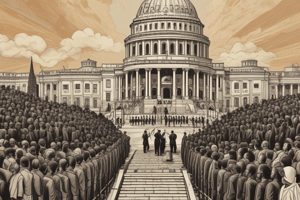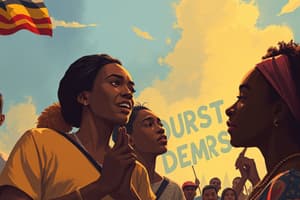Podcast
Questions and Answers
What was the significance of the Brown vs Topeka Board of Education decision in 1954?
What was the significance of the Brown vs Topeka Board of Education decision in 1954?
- It allowed for the continuation of racial discrimination in various public facilities.
- It provided a legal basis for the Montgomery Bus Boycott.
- It declared segregation in public schools unconstitutional. (correct)
- It upheld the principle of 'separate but equal'.
Which event was a direct response to the need for desegregation in public transportation?
Which event was a direct response to the need for desegregation in public transportation?
- The Washington March, 1963
- The Freedom Riders, 1960 (correct)
- The Birmingham March, 1963
- The Sit-ins, 1960
What was the primary goal of the Civil Rights Act of 1964?
What was the primary goal of the Civil Rights Act of 1964?
- To introduce affirmative action programs in education.
- To prohibit discrimination based on race, color, religion, sex, or national origin. (correct)
- To abolish the literacy tests for voting.
- To end racial segregation in schools.
What did the Voting Rights Act of 1965 aim to accomplish?
What did the Voting Rights Act of 1965 aim to accomplish?
How did the civil rights movement impact the identities of oppressed classes in society?
How did the civil rights movement impact the identities of oppressed classes in society?
What was a significant legal precedent set by the Plessy v. Ferguson case in 1896?
What was a significant legal precedent set by the Plessy v. Ferguson case in 1896?
Which of the following actions was NOT associated with nonviolent protest methods during the civil rights movement?
Which of the following actions was NOT associated with nonviolent protest methods during the civil rights movement?
What was one of the primary outcomes of the Birmingham March in 1963?
What was one of the primary outcomes of the Birmingham March in 1963?
How did the Civil Rights Act of 1964 primarily address issues of inequality?
How did the Civil Rights Act of 1964 primarily address issues of inequality?
What impact did Martin Luther King Jr.'s speeches have on the civil rights movement?
What impact did Martin Luther King Jr.'s speeches have on the civil rights movement?
Flashcards are hidden until you start studying
Study Notes
Rights and Privileges
- Rights are entitlements inherent to individuals; privileges are special advantages granted to certain groups or individuals.
- Civil rights involve personal and social freedoms ensuring equal treatment under the law.
Concepts Related to Civil Rights
- Ideology refers to a system of beliefs or concepts guiding political actions.
- Protest is a public demonstration expressing disapproval or advocating for change.
- Segregation denotes the enforced separation of different racial groups in society.
- Racial discrimination involves the unjust treatment of individuals based solely on their race.
Need for Social and Civil Rights
- Social and civil rights are essential for ensuring equality, justice, and protection against discrimination, crucial for a fair society.
Methods to Attain Rights
- Nonviolent protests, legal actions, advocacy, and community organizing are key strategies employed in the struggle for rights.
Case Study: US Civil Rights Movement
- A pivotal struggle primarily during the 1950s and 1960s aiming to end segregation and discrimination against African Americans.
Consequences of the End of the Civil War
- The Civil War’s conclusion led to the abolition of slavery and sparked ongoing battles for civil rights and social justice for formerly enslaved individuals.
Landmark Supreme Court Cases
- Plessy v. Ferguson (1896): Established 'separate but equal' doctrine, legitimizing racial segregation.
- Brown v. Topeka Board of Education (1954): Overturned Plessy, declaring racial segregation in public schools unconstitutional.
Key Events in the Civil Rights Movement
- The Montgomery Bus Boycott (1955): A pivotal protest against segregated public transportation led by figures like Rosa Parks and Martin Luther King Jr.
- Sit-ins (1960): Nonviolent protests in segregated spaces, primarily at lunch counters, to challenge racial discrimination.
- The Freedom Riders (1960): Activists rode interstate buses to challenge segregation in bus terminals across the South.
- Birmingham March (1963): A crucial event highlighting the violent repression faced by civil rights activists and the need for reform.
- Washington March (1963): Massive rally where Martin Luther King Jr. delivered his iconic "I Have a Dream" speech advocating for racial equality.
- The Civil Rights Act (1964): Legislation prohibiting discrimination based on race, color, religion, sex, or national origin.
- The Voting Rights Act (1965): Enacted to eliminate various barriers preventing African Americans from exercising their right to vote.
Martin Luther King Jr.’s Speech
- Delivered during the 1963 Washington March, emphasizing dreams of racial equality, justice, and harmony among all people.
Impact of Protest Movements
- Civil rights protests significantly reshaped identity and awareness among oppressed classes, enhancing their social relationships and interactions with broader society.
Rights and Privileges
- Rights are entitlements inherent to individuals; privileges are special advantages granted to certain groups or individuals.
- Civil rights involve personal and social freedoms ensuring equal treatment under the law.
Concepts Related to Civil Rights
- Ideology refers to a system of beliefs or concepts guiding political actions.
- Protest is a public demonstration expressing disapproval or advocating for change.
- Segregation denotes the enforced separation of different racial groups in society.
- Racial discrimination involves the unjust treatment of individuals based solely on their race.
Need for Social and Civil Rights
- Social and civil rights are essential for ensuring equality, justice, and protection against discrimination, crucial for a fair society.
Methods to Attain Rights
- Nonviolent protests, legal actions, advocacy, and community organizing are key strategies employed in the struggle for rights.
Case Study: US Civil Rights Movement
- A pivotal struggle primarily during the 1950s and 1960s aiming to end segregation and discrimination against African Americans.
Consequences of the End of the Civil War
- The Civil War’s conclusion led to the abolition of slavery and sparked ongoing battles for civil rights and social justice for formerly enslaved individuals.
Landmark Supreme Court Cases
- Plessy v. Ferguson (1896): Established 'separate but equal' doctrine, legitimizing racial segregation.
- Brown v. Topeka Board of Education (1954): Overturned Plessy, declaring racial segregation in public schools unconstitutional.
Key Events in the Civil Rights Movement
- The Montgomery Bus Boycott (1955): A pivotal protest against segregated public transportation led by figures like Rosa Parks and Martin Luther King Jr.
- Sit-ins (1960): Nonviolent protests in segregated spaces, primarily at lunch counters, to challenge racial discrimination.
- The Freedom Riders (1960): Activists rode interstate buses to challenge segregation in bus terminals across the South.
- Birmingham March (1963): A crucial event highlighting the violent repression faced by civil rights activists and the need for reform.
- Washington March (1963): Massive rally where Martin Luther King Jr. delivered his iconic "I Have a Dream" speech advocating for racial equality.
- The Civil Rights Act (1964): Legislation prohibiting discrimination based on race, color, religion, sex, or national origin.
- The Voting Rights Act (1965): Enacted to eliminate various barriers preventing African Americans from exercising their right to vote.
Martin Luther King Jr.’s Speech
- Delivered during the 1963 Washington March, emphasizing dreams of racial equality, justice, and harmony among all people.
Impact of Protest Movements
- Civil rights protests significantly reshaped identity and awareness among oppressed classes, enhancing their social relationships and interactions with broader society.
Studying That Suits You
Use AI to generate personalized quizzes and flashcards to suit your learning preferences.




